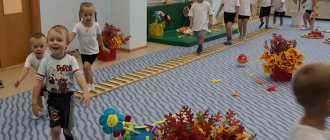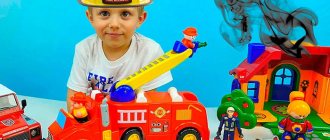Summary of a lesson in speech and alternative communication on the topic: “Maintaining a dialogue on a given topic.”
Abstract of speech and alternative communication.
Subject:
“Maintaining a dialogue on a given topic.”
During the classes:
Organizing time.
Communication game “Hello!”
(words and music by M. Kartushina)
.
Hello, palms! Extend your arms and turn your palms up.
Clap-clap-clap! 3 claps
.
Hello legs! Spring.
Top-top-top!
They stomp their feet.
Hello cheeks! Stroke cheeks with palms
.
Plop-plop-plop! Lightly pat the cheeks 3 times
.
Surprise moment.
Exercise "Cat".
(
The teacher brings 2 baskets
).
I brought you a basket. A big cat sits in it. The fur is very smooth,
The cat is very soft. Here are the eyes looking, here are the ears sticking out, here is the mouth with a mustache,
Here is a fluffy tail, here are four paws, and there are scratches on them. ( during the reading of the poem, the teacher asks the children: Seryozha, show me where the cat’s eyes are? Where are your eyes? Maxim, show me where the ears are? Are these ears?
- Let's show how a cat walks. She walks quietly, inaudibly. Follow me, everyone.
We'll show you a little, ( The children walk quietly on tiptoe
) the cat steps softly.
Barely audible: top-top-top, (onomatopoeic
)
Tail down: op-op-op.
- And the cat didn’t come alone. Look, kittens are sleeping in a small basket. Let's take a look, just quietly so as not to wake the kittens ( the teacher removes the scarf from the basket, the basket is empty
).- Where are the kittens?
Seryozha, where are the kittens? No kittens? ( to achieve a response gesture, onomatopoeia
). — The kittens ran away. Let's look for them.
Playing with sand
(buckwheat, rice) (
children “immerse” their palms in the sand).
- Who is this? Are these kittens? (achieve an affirmative sound, gesture).
What kittens?
Kittens are small. Show how small they are (children show with a gesture).
- Look, what kind of cat? Is the cat big? Show me which cat is big? ( children gesture
).
— What is the kittens’ mother’s name?
Finger game “Kitten is naughty.”
The kitten calls its mother: “Meow-meow, meow-meow.” Children rhythmically connect the same fingers of both hands.
He didn't drink the milk: - Little, little, little, little.
Cross your fingers, rhythmically lower and raise your fingers.
Mom feeds her milk: - Mur - pur - pur, pur - pur - pur. Rhythmically stroke the back of the other with the palm of one hand.
Curls up in a small ball: - Ur - ur - ur, ur - ur - ur. Rhythmically rub fist against fist.
He will play with the ball. Tsap-tsap-tsap, tsap-tsap-tsap. Rhythmically clench and unclench your fingers.
And the thread will quickly unwind. Up-up-up, up-up-up. Make rhythmic circular movements of the index fingers around each other.
Game "Colorful Balls".
— Kittens love to play with balls. They played and scattered all the balls. Let's help collect them: yellow balls into a yellow box, green balls into a green box.
- Well done, you put all the balls into boxes correctly.
- Oh, who's that squeaking? ( audio recording of the mouse's voice sounds
). - That's right, it's a mouse (showing a toy - a mouse).
Game: “Catch up with the mouse.”
The kittens saw the mouse and ran after the mouse.
Children put kittens (finger toys made of felt) on their fingers and “walk” in the “footsteps” of the little mice.
Kittens walk, sing a song: - How do kittens sing a song?
( children imitate the voices of kittens
). Meow - meow, I'll catch the mouse.
Game "Fishing".
The kittens did not catch any mice and went to the river to catch fish (
children “catch” fish
).
We caught a lot. Let's put the big fish in a large bucket, and the small ones in a small one ( put the fish in buckets by size
).
Game "Treat".
The kittens are hungry - let's feed them
(silhouette image of kittens on a wooden clothespin on both sides; press - feed (fish
).
Communication game “Farewell”
(words and music by M. Kartushina).
Goodbye, goodbye, goodbye, friends! We'll wave goodbye to everyone, you and me. ( Children wave their hands
).
Reflection.
- Who came to visit us today?
( children show
).
- Sergey, show me where the cat is? Maxim, show me where the kittens are? What cat? What kittens? ( show with a gesture
).
That's right, a cat with kittens came to us. The cat is big and the kittens are small. We helped the kittens collect balls. Sergey, show me where the yellow balls are? Maxim, show me where the green ones are? We fed the kittens fish. We made beautiful fluffy rugs for the kittens. ( The teacher invites the children to play with the cat and kittens on their own
.)
Summary of a dominant music lesson in the preparatory group of a kindergarten
Summary of the dominant music lesson “Let's go visit the Gnome, we'll find a miracle song!”
(preparatory group) Objectives: Educational: 1. Teach children to sing meaningfully and artistically expressively, purely intoning the melody. Developmental: 2. Continue to develop the mobility of the articulatory apparatus, expand the pitch range. Educational: 3. To instill in children an interest in singing. 4.Form moral qualities: a sense of empathy, a desire to help (Gnome). Vocabulary work: Activation of the dictionary: “staff”. Individual work: to activate inactive, shy children. Previous work: preliminary learning of the song “The Motley Cap” by G. Struve, the chants “Miracle Ladder”, “Ay”, the dance “Chick and Brik”. Material used: Didactic tools: stave on an easel, bead notes of different colors (7 pieces); Audio equipment: stereo system, disc with recorded music. Methodological techniques for the structure of the lesson: Motivation : the music director turns to the children with a request to help the Gnome collect bead notes (motive of personal interest).
Musical greeting "Hello, guests!" Communicative game “Greeting” by I. Kartushina Game with singing “Who said hello?” I. Kartushina Exercise “Ride, ride on a horse” Work on breathing. Exercises “Cold wind”, “Warming hands”, “Snowflake”, “Echo”. Vocal intonation exercises: “Ay”, “Miracle ladder”, “Snowdrifts”. Game with movement. “It’s frosty outside…” Vocal and intonation exercise “Blizzard.” Listening to the song “Tilly-bom” by E. Zaitseva Learning the song “Tilly-bom” by E. Zaitseva Performing the song “Motley Cap”, music. G. Struve Musical-ri T. Suvorova Course of the lesson:
Children enter the hall.
Musical greeting from the music director with the children: “Hello, guys.” Reciprocal musical greeting of children. Music leader: Guys, we have guests today, let’s welcome our guests too. Musical greeting “Hello, guests” to the music “Hello, hello, Dear guests! Hello, hello, You are welcome!” Music leader: Now, let’s say hello to each other to the music. Communication game "Greeting".
To the music, children walk freely around the hall, when the music ends, they stop and greet in different ways those who are nearby.
Repeated 3 times. Music leader: Guys, now we are going to play the musical game “Who said hello?” Game with singing “Who said hello?”
The driver stands in the center of the circle with his eyes closed.
One of the children sings: “Hello, Maria (driver’s name)!” The driver guesses from the child’s voice, approaches him and shakes his hand. The music director takes the envelope. Music leader: This morning I met the Postman, he gave you a letter from the Dwarf from the magical forest, (shows an envelope), do you want to know what he writes to us? (opens): “Dear friends, I’m in trouble! An angry blizzard flew into our forest, and my notes-beads scattered throughout the forest and now I can’t sing my favorite song. Guys, please help me collect the bead notes! Gnome” - Well, do you want to go into the forest and help the good Gnome collect his note-beads? Children: Yes! Music leader: What will we go on? Children: On a horse! Sledging! Exercise “Ride, ride on a horse”
We ride, ride on a horse (children click their tongues) On the smooth winter road (Click their tongues) The sleigh creaks (creak, creak, creak) The bells ring (ding, ding, ding) The woodpecker knocks (knock, knock , knock) The blizzard is whistling (whistle) We're riding, we're riding a horse (clicking their tongue) On a smooth winter road (clicking their tongue) Cold, cold, cold, cold (oooh) Fluffy snow is circling, circling (circling) We rode, we rode finally we arrived.
Whoa, here we come! Music leader: Oh, guys, look, here is the first bead note! (points to the note-bead that lies on the stump) We need to return the note to its place, on the staff. (The music director attaches the first note-bead) Where should the note be returned? Children: On the staff. Music leader: What’s the weather like in the forest? Are you cold? Children: Yes, it’s cold in the forest, it’s snowing. Music leader: Now I suggest you warm up. A little effort will improve your breathing. Breathing exercises.
Feel the cold on your palms.
Like a magician, the frost applied patterns to the windows. Exercise “Cold Wind”.
We'll warm up a little. Warm your palms.
Exercise “Warming your hands.” A breeze has appeared, We will blow on the snowball Exercise “Snowflake”.
Music
leader: Well, we’ve warmed up. Guys, I’ll tell you a secret, a magical echo lives in this forest. Let's listen to him. Exercise "Echo". Music leader : Echo, please tell us, have you seen the bead notes that the Gnome lost? Echo: Saw-lo-lo-lo! On the Christmas tree, Christmas tree, Christmas tree! Music leader : Look, what a beautiful Christmas tree, what’s on it? (children find the second note-bead on the Christmas tree and one of them attaches it to the staff). Music leader: Where do we place the bead note? Children: On the staff. Music leader: Well done, we found another bead note! Whose house do you think is visible in the distance? Children: Gnome's House! Music leader: We need to call the Gnome. Exercise "Aw!"
– achieve the sound of the head resonator on the sound “U”, repeat 3 times with an increase by a semitone.
Music leader: The Dwarf doesn’t appear, maybe he’s not at home? Let's look into the house, look - there is a ladder! I suggest you sing the “Miracle Little Ladder” song, maybe the Gnome will hear us! Exercise-singing “Miracle ladder”.
Music
manager: I noticed another bead on the roof? (attach the third note-bead) Where should it be attached? Children: On the staff. Music leader: The gnome is not at home, he is probably also looking for bead notes in the forest for his song. Let's follow in his footsteps. Look how much snow there is! Draws attention to the rope laid out in waves on the floor, snowflakes-points between the waves above and below. See what this drawing looks like? Children's answers. Music leader: It also seems to me that this drawing looks like snowdrifts. Snowdrifts often have bizarre shapes. Now I just want to sing the snowdrift song. Exercise "Sdrifts".
Singing along lines and dots to the sound “u” and “o” (“drifts” are laid out on the floor from rope) Music.
leader: Who wants to come up with their own song? Children change the movement of the rope and sing a “new song”. After the exercise, the fourth bead note is found. Game with the movement “It’s frosty in our yard.”
It’s frosty in our yard.
To keep your nose from freezing, you need to stomp your feet and clap your palms. (Children slap their hands on their shoulders and stomp their feet.) Now let’s imagine summer. The river is warmed by the sun. We swim, swim, swim, reaching the bottom with our feet. (Swimming movements with hands.) We leave the river and head to the edge. (Walking in place.) Music. leader: What is the name of a natural phenomenon when a strong wind blows and it snows? Children: blizzard, blizzard... Music. leader: Let's try to portray a blizzard. Exercise "Blizzard".
Singing in unison with a semitone increase.
Music leader: Guys, I want to introduce you to a new song? “Tilly-bom” by E. Zaitseva – listening.
Questions: •Who is this song about?
•What is the nature of the music (sad, melancholy, cheerful, kind, gentle, soulful) “Tilly-bom” by E. Zaitseva – learning. Techniques: •Singing by the music director. •The music director sings the verse, the children sing the chorus. Music leader: Guys, you sang so well! We have one more bead note (on the piano he finds the sixth bead note). The Gnome comes in to the music “Motley Cap”. He holds the seventh bead note in his hands. Gnome: Hello, guys! Did you get my letter? Children: Yes! We found six bead notes. Gnome: Thank you guys for helping me collect the bead notes and now I can sing you my funny song! The gnome sings the first verse of the song “The Motley Cap.” Dwarf: Do you want to sing together? Children, together with the Dwarf, perform the song “Motley Cap” Performing the song “Motley Cap”
Techniques: • Singing phrases in a “chain”.
•Quiet - loud. Dramatization of the song “Motley Cap” Dwarf: How fun it is to be with you that I even want to dance! Dance “Chick and Brick”
Gnome: Thank you again and goodbye! The children say goodbye to the guests and leave for the group.
We recommend watching:
Integrated GCD for music for kindergarten. Preparatory group Summary of educational activities on music for children of the preparatory group Music lesson in the senior group with TRIZ elements: Seasons Essay by the music director of the preschool educational institution
Similar articles:
Musical lesson in the senior group. Abstract
Musical-themed lesson on rhythm for the preparatory group of kindergarten
Music room scenario for children of senior and preparatory groups of preschool educational institutions
Scenario of musical leisure in the preparatory group of a preschool educational institution. Music by Shainsky
Musical festival in the preparatory group of kindergarten. Pushkin and music







